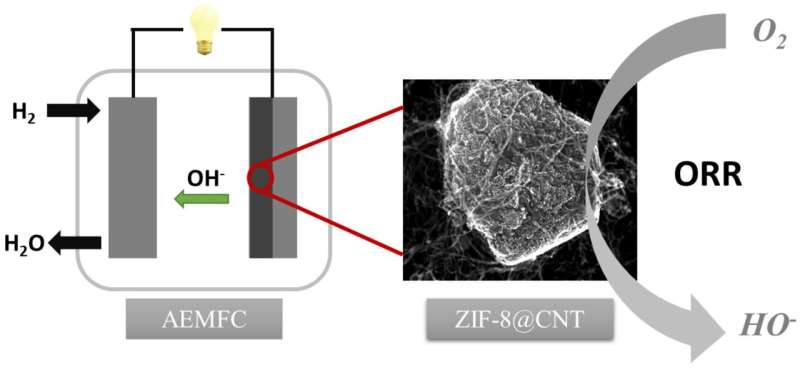This article has been reviewed according to Science X's editorial process and policies. Editors have highlighted the following attributes while ensuring the content's credibility:
fact-checked
proofread
Metal-free and transition-metal-doped ZIF-8@CNT catalysts prepared by one-step high-temperature pyrolysis

Non-precious metal catalysts (NPMC) have strong potential in energy conversion devices due to their excellent oxygen reduction reaction (ORR) performance in fuel cells. Since in most NPMC materials, the accessible active sites play a vital role in oxygen electrocatalysis, recent research attention has been diverted towards developing transition metal-containing carbon-based conductive and porous catalyst materials for ORR application.
A team of scientists has constructed micro-mesoporous metal-organic framework (MOF) and carbon nanotube (CNT)-based carbon composite catalysts showing excellent ORR electrocatalytic activity in alkaline solution at minimal catalyst loadings. The presence of MNx sites was found responsible for the enhanced electrocatalytic activity of the catalysts when transition metals were incorporated into the MOF- and CNT-derived carbon skeleton.
Their work was published in the journal Industrial Chemistry & Materials on September 06, 2023.
To mitigate global warming, current research and development in the field of renewable energy generation has received a lot of attention. In this context, anion exchange membrane fuel cells (AEMFCs) that use O2 or air at the cathode to produce electric power have pulled significant attention in the scientific community due to their relatively mild operating conditions. However, the sluggish kinetics of the cathodic oxygen reduction reaction (ORR) and insufficient durability of Pt-based catalysts are significant disadvantages in their practical applications.
Large efforts have been made during the last decade to develop highly active transition metal-nitrogen-carbon (M-N-C) type catalysts for ORR. Various transition metal-based electrocatalysts have been explored as cost-efficient materials for catalyzing the ORR in alkaline medium, nonetheless, it is challenging to identify a single-metal catalyst as an alternative to Pt-group metal catalysts for ORR. Bimetallic electrocatalysts are expected to have altered electronic properties favorable for enhanced electrocatalytic activity.
Metal-organic frameworks (MOFs) have significant advantages in catalyst tuning and structure optimization and their derivatives usually have highly dispersed accessible active sites, improved charge transfer networks and hierarchical porosity for efficient mass-transfer of reactants. The research team was able to successfully fabricate MOF- and carbon nanotube (CNT)-based carbon composite with iron and cobalt coordinated to nitrogen in the doped carbon material with three-dimensional micro-mesoporous structure and employed it for ORR electrocatalysis.
They used high-temperature pyrolysis of ordered zinc-based zeolitic-imidazolate framework (ZIF) in creating the micro/mesoporous carbon composite with CNTs. With the synthesized composite catalysts, the team achieved high electrocatalytic ORR activity in the alkaline media (0.1 M KOH) by achieving the half-wave potential of 0.85 V vs RHE, which surpasses the activity of Pt/C catalyst. The prepared bimetallic catalysts showed good performance when tested in AEMFC by achieving the maximum power density of 171 mW cm-2 with Aemion+ 15 μm anion exchange membrane (AEM).
Looking ahead, the research team hopes that their work might provide insights into the development of transition metal and nitrogen co-doped hierarchically porous carbon-based composite catalysts for fuel cell applications.
"Our next plan is to optimize various M-N-C type cathode catalysts to achieve even higher power outputs from AEMFCs. Our developed non-precious metal electrocatalysts may be potentially used in various other applications viz. zinc-air batteries, proton exchange membrane fuel cells," said Kaido Tammeveski, a professor at University of Tartu.
The research team includes Rohit Kumar, Marek Mooste, Zubair Ahmed, Srinu Akula, Ivar Zekker, Margus Marandi, Maike Käärik, Jaan Leis, Arvo Kikas, Alexey Treshchalov, Markus Otsus, Jaan Aruväli, Vambola Kisand, Aile Tamm, and Kaido Tammeveski from the University of Tartu, Estonia.
More information: Rohit Kumar et al, Highly active ZIF-8@CNT composite catalysts as cathode materials for anion exchange membrane fuel cells, Industrial Chemistry & Materials (2023). DOI: 10.1039/D3IM00081H
Provided by Industrial Chemistry & Materials





















